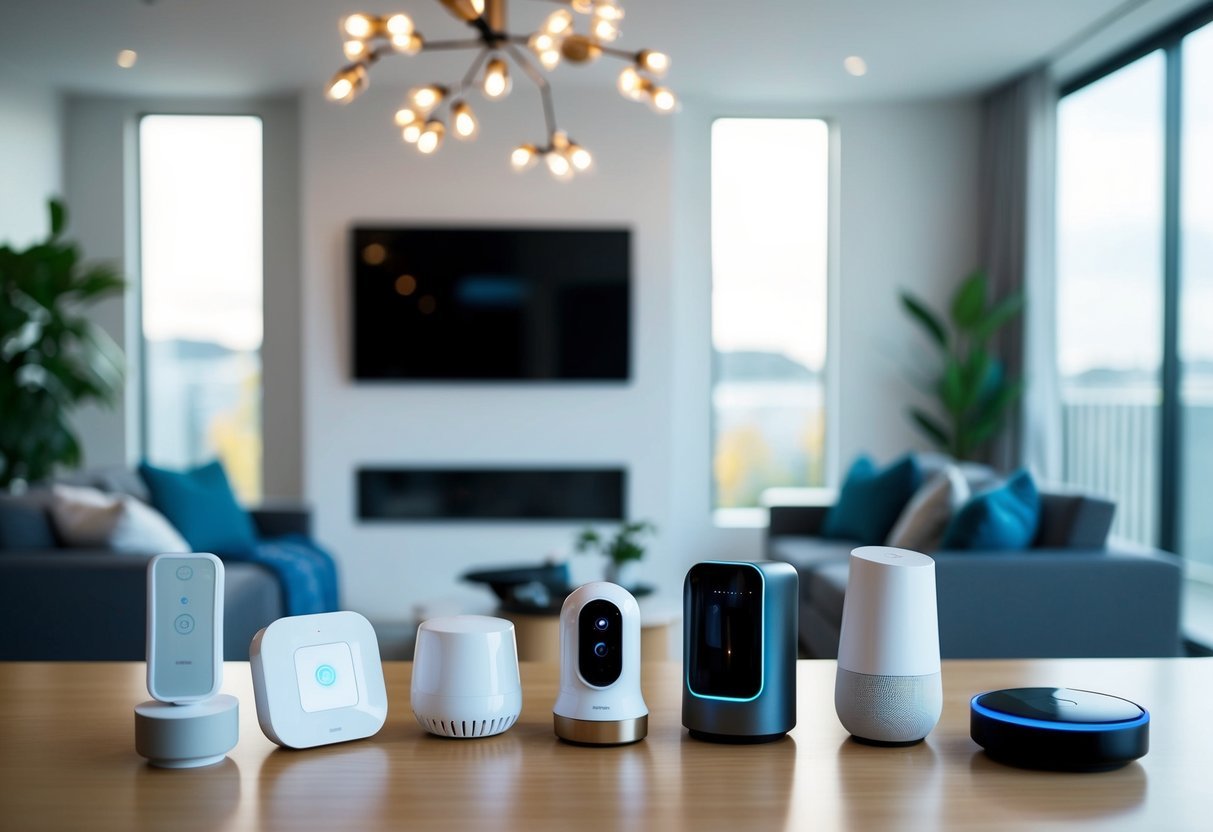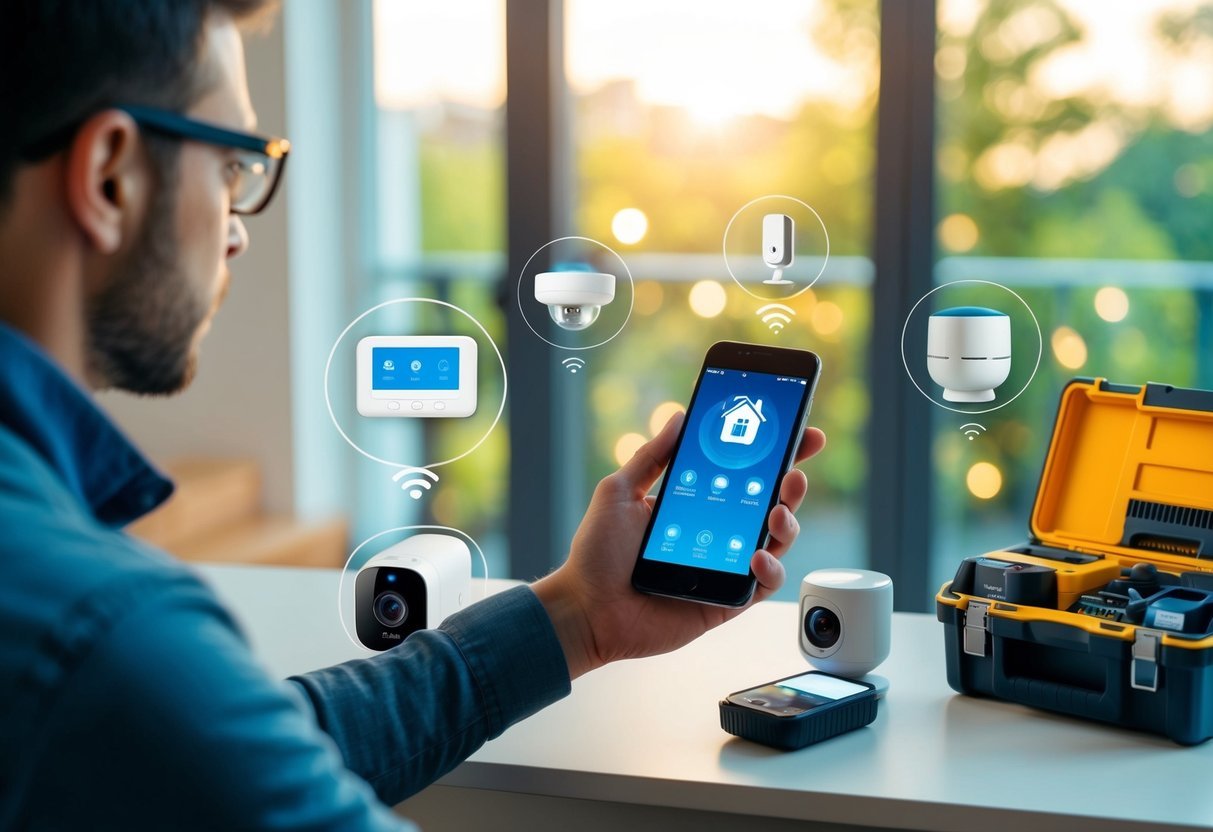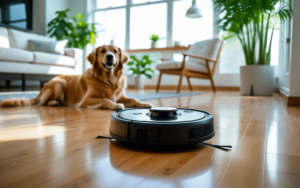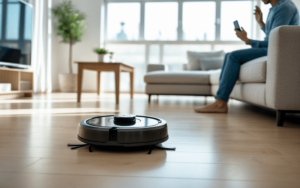https://amzn.to/3R19TgSSetting up a smart home might seem overwhelming at first, but it doesn’t have to be complex. Starting with basic devices like smart lights, speakers, or doorbell cameras can transform your living space into an efficient, automated environment that enhances comfort and convenience. The technology has become increasingly accessible to beginners, with user-friendly apps and voice assistants making control simpler than ever before.
Before diving in, it’s helpful to understand the different connectivity protocols and how various devices work together. Making informed choices about which ecosystem to invest in—whether Amazon Alexa, Google Home, or Apple HomeKit—will save you frustration later. The right foundation allows for seamless expansion as you grow more comfortable with smart home automation.
Please note that this article contains affiliate links. As an Amazon Associate, we earn from qualifying purchases at no extra cost to you.
Key Takeaways
- Begin with essential devices like smart lights or speakers before expanding to more advanced sensors and systems.
- Choose a compatible ecosystem that will support your current and future smart home needs.
- Understanding connectivity options and planning your setup carefully will prevent integration problems and compatibility issues.
Understanding Smart Home Basics
Before diving into smart home technologies, it’s important to grasp the fundamental concepts that power these systems and the value they can bring to your daily life. Smart homes combine connectivity, automation, and intuitive controls to transform ordinary living spaces.
What Is a Smart Home?
A smart home is a residence equipped with devices that can be controlled remotely via an internet connection using a smartphone, tablet, or voice commands. These connected devices communicate with each other and can be programmed to follow specific routines or respond to triggers.
The concept revolves around automation and convenience, allowing homeowners to manage various aspects of their living environment without manual intervention. Common elements include lighting, thermostats, security systems, and entertainment devices.
Smart home systems can range from simple setups with a few connected devices to comprehensive ecosystems that manage nearly every aspect of a home. The level of integration depends on user preferences and budget considerations.
Modern smart homes operate through various connectivity protocols like Wi-Fi, Bluetooth, Zigbee, or Z-Wave, creating a network that enables seamless device communication.
Benefits of a Smart Home
Enhanced convenience stands as one of the primary advantages of smart home technology. Automating routine tasks like adjusting thermostats or turning off lights eliminates the need for manual control.
Energy efficiency improves significantly with smart systems. Programmable thermostats, automated lighting, and intelligent power management can reduce utility bills by optimizing energy use only when needed.
Improved security is achieved through connected doorbell cameras, motion sensors, and smart locks that allow homeowners to monitor their property remotely and receive real-time alerts about potential security breaches.
Accessibility features benefit elderly or disabled individuals by providing voice-controlled operations and automated routines that reduce physical demands.
Home value increases with smart technology installations, as modern buyers increasingly expect these conveniences in new homes.
Components of a Smart Home System
Central hub or controller: Acts as the brain of your smart home system, allowing different devices to communicate. Examples include Amazon Echo, Google Home, or dedicated smart home hubs from companies like Samsung or Apple.
Connected devices form the functional elements of your system:
- Smart speakers
- Intelligent lighting
- Wi-Fi thermostats
- Security cameras
- Smart locks
- Automated window coverings
- Connected appliances
We may earn a small commission if you purchase through this link with no extra costs for you. Thank you for supporting our content!
Connectivity infrastructure must be robust for reliable operation. A stable Wi-Fi network serves as the foundation for most smart homes, though some systems may require additional connectivity protocols like Zigbee or Z-Wave.
Control interfaces provide access to your system through smartphone apps, voice commands, wall-mounted panels, or automated routines. Most systems offer multiple control options for convenience and redundancy.
Planning Your Smart Home Setup
Effective smart home implementation requires thoughtful planning before purchasing any devices. A well-designed strategy will save money, reduce compatibility issues, and create a system that truly enhances your lifestyle.
Setting Goals and Budgeting
Begin by identifying what problems you want your smart home to solve. Are you focused on convenience, security, energy efficiency, or entertainment? Each goal will guide different purchasing decisions.
Create a priority list of rooms or functions you want to automate first. Many experts recommend starting with a few essential devices rather than attempting to automate everything at once.
Establish a realistic budget with both initial setup costs and ongoing expenses. Smart home systems can range from basic setups under $100 to comprehensive systems costing thousands. Consider subscription fees for certain services that may add to long-term costs.
Remember that quality often matters more than quantity. A few reliable devices will provide better value than numerous budget options that may need frequent replacement.
Choosing an Ecosystem
Selecting a compatible ecosystem is crucial for seamless device integration. Major platforms include Amazon Alexa, Google Home, Apple HomeKit, and Samsung SmartThings.
Consider which voice assistant you prefer and which smartphones you already use. Apple users might benefit from HomeKit’s tight integration, while Android users might prefer Google’s ecosystem.
Check which devices support your chosen platform before purchasing. Some devices work with multiple ecosystems, offering greater flexibility, while others are platform-exclusive.
The connectivity protocols your devices use (Wi-Fi, Zigbee, Z-Wave, Bluetooth, Matter) will affect compatibility and performance. Wi-Fi devices are common but can congest your network, while Zigbee and Z-Wave create separate mesh networks.
Creating a Scalable Plan
Design your smart home with future expansion in mind. Starting with a solid foundation allows for smoother additions later without complete system overhauls.
Consider purchasing a dedicated smart home hub if you plan to incorporate numerous devices or diverse protocols. Hubs can unify management of various devices through a single interface.
Map your home’s layout, noting potential signal challenges like thick walls or large square footage. This planning helps determine if you’ll need range extenders, mesh networks, or strategically placed hubs.
Begin with foundational devices like smart speakers, lighting, and perhaps thermostats. These elements create a framework that other specialized devices can build upon as your system grows.
Document your setup process, including account information, network details, and device specifications. This reference will prove invaluable when troubleshooting or expanding your system.
Getting Started with Core Devices
Building a smart home starts with selecting the right foundational devices that will work together seamlessly. The proper setup of key components ensures your smart home functions efficiently and meets your specific needs.
Smart Hubs and Controllers
Smart hubs serve as the central command center for your entire smart home ecosystem. These devices connect and communicate with various smart products, allowing them to work together regardless of brand or communication protocol. Popular options include Amazon Echo with Alexa, Google Nest Hub with Google Assistant, and Apple HomePod with Siri.
When selecting a hub, consider which voice assistant ecosystem best matches your existing devices. For example, if you already use iPhone and Apple products, a HomePod might integrate more smoothly with your lifestyle.
Some advanced hubs like Samsung SmartThings support multiple connectivity standards (Zigbee, Z-Wave, Wi-Fi, Bluetooth), providing greater flexibility. This versatility becomes important as your smart home expands with additional devices.
Essential Smart Devices
Begin with these fundamental smart devices to build a practical foundation:
Smart Lighting: Smart bulbs or switches offer convenience through app control and automation. Brands like Philips Hue, LIFX, and Wyze provide various options at different price points.
Smart Speakers: These serve as both voice control points and entertainment devices. Popular choices include Amazon Echo, Google Nest Audio, and Apple HomePod Mini.
Smart Plugs: Convert regular appliances into smart ones without replacing them. These allow remote control of lamps, coffee makers, and other non-smart devices.
Security Devices: Basic security cameras or video doorbells provide peace of mind and practical utility. Brands like Ring, Arlo, and Eufy offer reliable entry-level options.
Smart Thermostats: These learn your preferences and help reduce energy consumption while maintaining comfort.
Installation Best Practices
Stable Wi-Fi is the backbone of any smart home system. Consider a mesh network if your home has Wi-Fi dead zones, as reliable connectivity is essential for smart device performance.
Create a dedicated smart home network when possible, separating IoT devices from your main network to enhance security. This approach also reduces network congestion.
Keep firmware updated on all devices to ensure optimal performance and security. Most quality smart devices offer automatic updates, but periodically check that they’re running the latest versions.
Document your setup, including device passwords, network names, and account information. This documentation proves invaluable when troubleshooting or expanding your system later.
Start with basic devices before moving to more complex sensors and systems. This approach helps you learn the fundamentals while building confidence in your smart home management abilities.
Connecting and Automating Your Devices

Once you’ve selected your smart home devices, the real magic happens when you connect them and create automated systems that work together seamlessly. Proper integration and thoughtful automation routines transform individual gadgets into a comprehensive smart home ecosystem.
Integration Techniques
The foundation of device connectivity relies on understanding protocols like Zigbee, Z-Wave, Wi-Fi, and Bluetooth. These protocols determine how your devices communicate with each other and your central hub or controller system.
Smart home hubs act as the brain of your operation, allowing different devices to work together regardless of their manufacturer. Popular options include Samsung SmartThings, Amazon Echo devices, and Google Nest Hub.
For beginners, choosing devices within the same ecosystem (Apple HomeKit, Google Home, or Amazon Alexa) simplifies the setup process significantly. This approach reduces compatibility issues and streamlines the user experience.
Voice assistants provide convenient control methods across multiple devices. Setting up routines through voice commands can trigger several actions simultaneously, enhancing your smart home functionality.
Developing Automation Routines
Automation routines transform smart devices from novelties into practical home solutions. Start with simple automations like scheduling lights to turn on at sunset or setting your thermostat to adjust when you leave home.
Common Automation Types:
- Time-based: Devices activate at specific times (coffee maker at 7am)
- Sensor-based: Actions triggered by motion, temperature, or door sensors
- Location-based: Systems respond to your phone’s GPS location
- Conditional: If-this-then-that sequences based on specific conditions
Beginner automation routines might include morning and evening sequences that control multiple devices with a single command. For example, saying “Good morning” could open blinds, adjust thermostat, and play news briefings.
Test automations thoroughly before relying on them, especially for security-related functions. Start with non-critical systems until you feel confident in your setup.
Securing Your Smart Home Network
Security should be a top priority when connecting multiple smart devices to your home network. Each connected device represents a potential entry point for unauthorized access.
Create a separate network or VLAN specifically for smart home devices to isolate them from your primary network containing sensitive information. This limits potential damage if a device is compromised.
Always change default passwords and usernames on all devices and associated accounts. Use strong, unique passwords and enable two-factor authentication wherever available.
Keep all devices updated with the latest firmware to protect against newly discovered vulnerabilities. Many modern devices can update automatically, but some require manual updates.
Consider the privacy implications of each device before installation. Research manufacturer privacy policies, understand what data is collected, and disable unnecessary features that may compromise privacy.
Troubleshooting and Maintenance

Even the most well-designed smart home systems encounter issues and require regular care to function optimally. Proper maintenance ensures your devices continue to work seamlessly together while troubleshooting skills help resolve inevitable technical hiccups.
Common Smart Home Issues
Connectivity problems rank among the most frequent smart home challenges. When devices won’t connect, try the classic IT solution of restarting both the problematic device and your router. This simple step resolves surprising numbers of connection issues.
Wi-Fi interference can hamper system performance, especially in homes with numerous connected devices. Consider reaching out to device manufacturers for specific troubleshooting tips if installation or connectivity problems persist.
Voice assistants sometimes misinterpret commands or fail to respond. Try rephrasing your request or moving closer to the device. Background noise often interferes with voice recognition.
Quick Troubleshooting Checklist:
- Check device power and battery levels
- Verify Wi-Fi signal strength where devices are placed
- Confirm firmware is updated
- Ensure compatible protocols between devices
Updating and Upgrading Your System
Regular software updates are crucial for security and performance. Most smart home hubs and devices offer automatic updates, but verify these settings are enabled in each device’s app.
Firmware updates often add new features while patching security vulnerabilities. Schedule monthly checks for any devices not set to update automatically to ensure optimal protection.
When building or expanding your smart home system, maintain compatibility by researching before purchases. Not all protocols work together seamlessly, and mixing technologies like Z-Wave, Zigbee, and Wi-Fi requires careful planning.
Consider future-proofing when upgrading components. Smart home technology evolves rapidly, so prioritize devices with established manufacturer support and a history of regular updates.
Ongoing System Care
Monthly testing of critical systems like security cameras, alarm triggers, and automated emergency responses ensures they’ll work when needed. Create a simple testing schedule and stick to it.
Data privacy requires vigilance as most smart devices collect usage information. Review privacy settings quarterly and disable unnecessary data collection features that don’t benefit your user experience.
Developing an understanding of your system’s technologies helps with maintenance. Knowing whether your devices use Wi-Fi, Zigbee, or Z-Wave affects troubleshooting approaches and expansion decisions.
Battery-powered devices need regular checks. Create calendar reminders for devices with non-rechargeable batteries to prevent unexpected failures. Smart smoke detectors and door sensors are particularly important to monitor.
Frequently Asked Questions

Smart home technology brings convenience and efficiency but often raises important questions for newcomers. These common inquiries address device selection, system integration, setup procedures, and security considerations that beginners frequently encounter.
What are the essential devices needed for a beginner’s smart home setup?
For beginners, a solid smart home foundation starts with a few key devices. A smart speaker with voice assistant capability (like Amazon Echo, Google Nest, or Apple HomePod) serves as an excellent control center.
Smart lighting represents one of the most accessible entry points, with smart bulbs or switches offering immediate benefits without complex installation. These devices provide immediate functionality while allowing gradual expansion.
A smart thermostat delivers both convenience and potential energy savings, making it another worthwhile initial investment. For security, consider adding a video doorbell or indoor/outdoor cameras.
Smart plugs also provide exceptional value by transforming regular appliances into controllable devices without requiring complete replacement.
How do you integrate different smart home systems for streamlined control?
Integration between different smart home ecosystems typically requires a hub or compatible control platform. Many modern smart home systems use standardized protocols like Matter, which improves cross-platform compatibility.
Apps like Google Home, Amazon Alexa, or Apple HomeKit can serve as central control platforms that connect multiple device brands. These platforms allow users to create scenes that trigger multiple devices simultaneously.
Voice commands through smart assistants enable seamless control across various devices regardless of manufacturer. For advanced integration, platforms like Home Assistant or SmartThings provide robust solutions for connecting diverse devices.
What are the steps to configure a smart home using Google Home?
Setting up Google Home begins with downloading the Google Home app and creating an account. The app guides users through connecting the Google Nest speaker or display to the home’s Wi-Fi network.
Adding devices involves selecting “Add device” in the app and following the specific instructions for each product. Most manufacturers provide Google Home compatibility details in their setup instructions.
Creating routines enhances functionality by automating multiple actions with a single command. Users can configure routines like “Good morning” to turn on lights, adjust the thermostat, and provide a weather update simultaneously.
Voice training improves recognition accuracy, especially in homes with multiple users. Regular updates ensure optimal performance and security protections.
What are the primary considerations for choosing a central smart home hub?
Compatibility with existing and planned devices represents the most crucial factor when selecting a smart home hub. Different hubs support various protocols like Zigbee, Z-Wave, Wi-Fi, and Bluetooth.
Processing location matters—some hubs process data locally for enhanced privacy and faster response times, while others rely on cloud connections. Local processing typically offers better reliability during internet outages.
User interface design significantly impacts daily usability. The learning curve differs between platforms, with some prioritizing simplicity and others offering advanced customization.
Long-term support from the manufacturer ensures continued functionality and security updates. Well-established brands typically provide more reliable ongoing support.
How can one ensure compatibility among various smart home devices?
Researching device compatibility before purchasing helps avoid integration issues. Manufacturers typically list compatible ecosystems (Google Home, Amazon Alexa, Apple HomeKit) on packaging and websites.
Standard protocols like Matter, Zigbee, and Z-Wave increase the likelihood of cross-platform compatibility. These open standards are designed specifically to address fragmentation in the smart home market.
Online communities and forums offer valuable real-world compatibility insights. Users share experiences with specific device combinations that might not be covered in official documentation.
Testing with a small investment before committing to an entire ecosystem minimizes potential losses. Starting with versatile devices that work across multiple platforms provides flexibility.
What is the process for setting up a smart home network securely?
Creating a strong, unique password for the Wi-Fi network establishes the foundation for smart home security. Avoiding default credentials prevents unauthorized access to connected devices.
Regularly updating firmware on all devices patches security vulnerabilities. Many devices offer automatic updates, which should be enabled whenever possible.
Network segmentation using a dedicated VLAN for smart devices adds an extra security layer. This approach contains potential breaches within the smart home network rather than exposing the primary network.
Enabling two-factor authentication provides additional protection for smart home accounts. Security considerations should include reviewing each device’s privacy settings and understanding what data is being collected and shared.
This article contains affiliate links, which means we may earn a commission if you purchase through our links, at no extra cost to you. As an Amazon Associate, we earn from qualifying purchases. Thank you for supporting our content!




